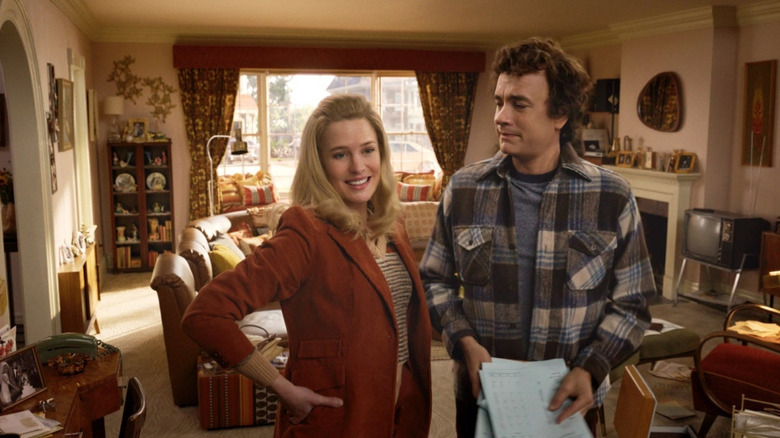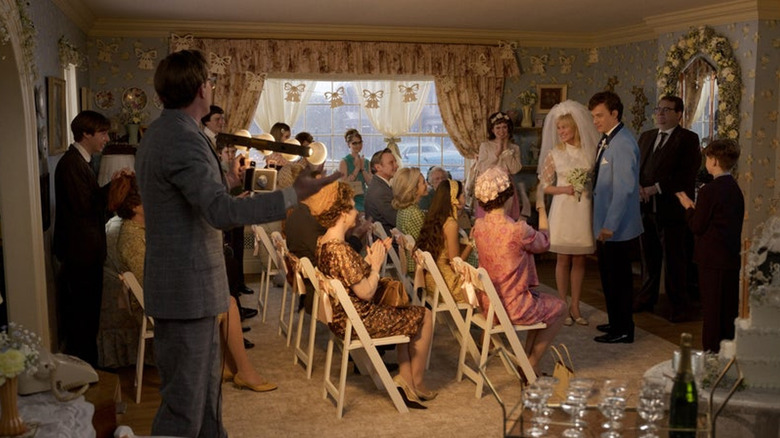
TriStar Pictures
Robert Zemeckis has always been a filmmaker who doubles as a magician. His films are loaded with neat little tricks, and, as is the case with any good magician, you find yourself wondering how he pulled them off. His debut "I Wanna Hold Your Hand" used clever editing, archival footage, and stand-ins to recreate the Beatles' debut on The Ed Sullivan Show. The "Back to the Future" trilogy is bursting with eye-popping special effects. "Who Framed Roger Rabbit" seamlessly blended live-action and animation. "Death Becomes Her" is overloaded with gross-out gags. "Forrest Gump" found fun little ways to insert Tom Hanks into moments of televised American history. The list goes on and on. But at some point, the trickery began to overwhelm the process. His "Beowulf," "The Polar Express," and "A Christmas Carol" embraced heavy motion-capture animation with ghastly, uncanny valley results ("The Polar Express" has somehow become a recurring holiday season staple even though the movie is quite bad). It started to seem like Zemeckis was more interested in the technology than he was in telling a good story, a depressing turn of events since the script for "Back to the Future," which Zemeckis co-wrote, is one of the best of the best.
When was the last time Zemeckis made a really good movie? I imagine everyone's opinion will vary on this. Some folks seem to like his Denzel Washington flick "Flight" from 2012, but other than an admittedly thrilling plane crash sequence, the movie itself doesn't do much for me. I've seen others praise his World War II movie "Allied" from 2016, but that also left me cold. I can't remember the last time I heard someone mention his 2015 movie "The Walk." And pretty much no one likes his most recent three movies: the abysmal "Welcome to Marwen" and forgettable remakes of "The Witches" and "Pinocchio." If you're asking me, the last truly good Zemeckis movie is probably "Cast Away," which came out all the way back in 2000. As someone who has enjoyed several of Zemeckis' films (his sci-fi flick "Contact" is one of my all-time-faves), I'm always hoping for another touch of magic brilliance from the director. But time and time again, he seems to be his own worst enemy, and his magic act has grown stale. We're no longer awed and wondering how he did it. We're just waiting to see if he's learned some new tricks.
"Here" is the latest bit of movie hocus pocus from Zemeckis, and it has plenty of potential. Adapted from a graphic novel by Richard McGuire, the film has a fascinating hook: it's set in one spot, spanning millions of years. The movie starts all the way back in the time of the dinosaurs and ends up in (presumably) present day, but for almost the entire runtime, the camera never moves. It stays rooted in one specific location. In the past, we see both Indigenous people and, believe it or not, Benjamin Franklin (!!) travel past the camera's point-of-view, but for the bulk of the movie, we find ourself situated in the living room of a house built in 1907.
Here is a Forrest Gump reunion that uses digital de-aging effects

TriStar Pictures
Zemeckis, following in the footsteps of the graphic novel, plays around with time in "Here." The movie moves back and forth through history, sometimes at once — a trick the filmmaker accomplishes by dropping little window boxes into the frame to show us an event happening at another time in the same exact spot. On several occasions, Zemeckis uses this to draw parallels to various events, and there is more than one occasion where I get the impression that he's slyly hinting the house could even be haunted (or maybe that was my mind wandering to think about a much better movie). This setup could make for an interesting experiment — but I imagine it works better in graphic novel form than it does in film (full disclosure: I've never read the comic). For one thing, by locking the action in one place, Zemeckis and co-writer Eric Roth have to find excuses to have all the action rooted in one spot. This might be a suburban living room, but we see a funeral, a wedding, a birth, and even a death all in this one location. And since time is constantly moving around in the film, the script also forces characters to shout out exposition to keep the audience up to speed ("Our little girl is going to college!" a character will suddenly exclaim, only for the scene to then quickly fade and have the same character add: "I can't believe our little girl is graduating college!", and so on).
"Here" is sold as a big "Forrest Gump" reunion: not only is Zemeckis reuniting with that film's screenwriter, Roth, but that movie's stars, Tom Hanks and Robin Wright, also lead "Here." Sounds great on paper: Hanks and Wright are both excellent performers. Unfortunately, ever the magician, Zemeckis has employed the trickery of digital de-aging technology (the tech is enhanced using A.I. and seemingly created in-camera, though don't ask me to explain how it all works). I'm not entirely against digital de-aging (as long as it's being used on living actors, and not ghoulishly resurrecting the dead like in "Alien: Romulus"). In the right hands (see: Martin Scorsese's "The Irishman"), this process can pay off. And to be fair, the digital de-aging in "Here" doesn't really look bad. But it doesn't convince, either. At one point, Hanks' character's father, played by Paul Bettany, yells, "You're only 18!", an the illusion shatters, because we instinctively know that Tom Hanks is definitely not 18, no matter how digitally smooth his face may look.
Hanks plays Richard, a guy who dreams of being an artist. Richard lives in a house with his parents, Al (Bettany) and Rose (Kelly Reilly), who bought the house just after World War II (Richard also has some siblings, but they're barely characters here). One day, teenage Richard brings his girlfriend Margaret (Wright) to visit, and she seemingly never leaves. After a night of hanky-panky on the living room couch, Margaret gets pregnant. Since they're both still young, Richard and Margaret live with Richard's parents while the baby is born — and they keep living there long after. These kids get married (right in the living room), and Margaret understandably dreams of having a house of their own. But Richard, who is prone to worrying and loves to talk about how high taxes are, shrugs his wife's wishes off. They can't afford it! Why not keep living rent free with mom and dad? And so the years tick on, and time passes — a fact that the characters flat-out proclaim in dialogue over and over again, in case it wasn't clear enough ("Time sure does fly!").
Here has a fascinating concept executed poorly

TriStar Pictures
So let's say you can move beyond the frequently distracting digital de-aging. How does the rest of "Here" hold up? Unfortunately, while I think the idea of keeping the camera in one spot for an entire movie is interesting, the execution leaves a lot to be desired. A level of artificiality sets in that grows distracting. To be fair, all movies have this, in theory (they're all staged and directed and blocked a certain specific way, after all), but the setup of "Here" makes the stagey-ness glaringly obvious. While the production design does a great job displaying various eras, none of them feel real. It never once feels like we're looking at a real living room, but rather a set — and the fact that the camera angle never changes makes it feel like a studio TV set on top of that. Throw in all that digital de-aging, and "Here" ends up blanketed in an unshakable feeling of phoniness. It doesn't help that nearly all the performances are dialed up to 11 — Wright, in particular, seems to be shouting all of her lines for some reason, ditto Bettany. Only Hanks is able to find some sort of subtle note to play here.
The constant shifts in time also begin to grow distracting. If Zemeckis and Roth had focused entirely on Richard, Margaret, and their extended family over the years, it would play much better. Instead, we're frequently being shown snippets of other people who lived in the house. There's a stuffy woman (Michelle Dockery) in the early 1900s who worries that her aviator husband (Gwilym Lee) is spending too much time flying his airplane, and there's a perpetually hory couple (David Fynn and Ophelia Lovibond) in the 1920s who spend all their time dancing around the living room and eventually invent something I won't dare spoil. I found these segways uninteresting to the extreme (and grew particularly annoyed with the 1920s couple, who behave like characters in a terrible high school play). By the time the film threw in a jumpscare featuring Ben Franklin, I was ready to call it a day.
All of this is overlaid with a painfully cloying score by Alan Silvestri (another "Forrest Gump" team member) that clobbers us over the head with sappy sentimentality. You get the sense that "Here" wants to be bold enough to encapsulate all of life's joys and heartbreaks, but only the heartbreaks stand-out. This is ultimately a terribly sad movie about shattered dreams; a constant reminder that life is a long, sad affair that ultimately ends in tragedy. I don't think there's anything wrong with a film highlighting that, but the movie's moments of sadness are so pronounced that they completely smother the failed attempts to portray happiness. Silvestri's score seems to be attempting to counter the bleakness by blasting sweeping, joyful notes, but they ring hollow. And so does the film as a whole. Robert Zemeckis might still be a movie magician, but "Here" suggests the magic is gone.
/Film Rating: 5 out of 10
"Here" opens in theaters on November 1, 2024.




:quality(85):upscale()/2024/10/29/957/n/1922441/c62aba6367215ab0493352.74567072_.jpg)

:quality(85):upscale()/2024/10/29/987/n/49351082/3e0e51c1672164bfe300c1.01385001_.jpg)
:quality(85):upscale()/2024/10/30/711/n/1922441/c62313206722590ade53c4.47456265_.jpg)

 English (US) ·
English (US) ·